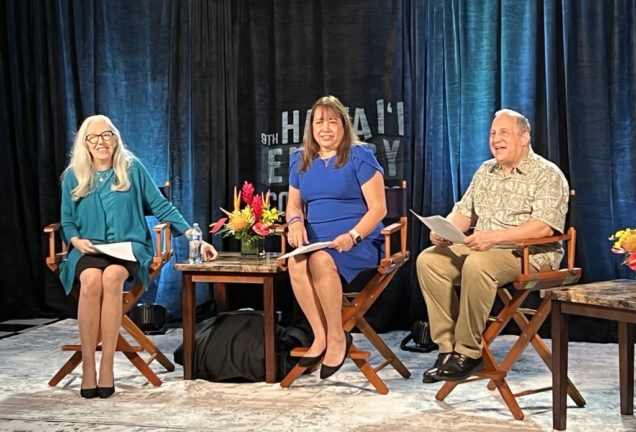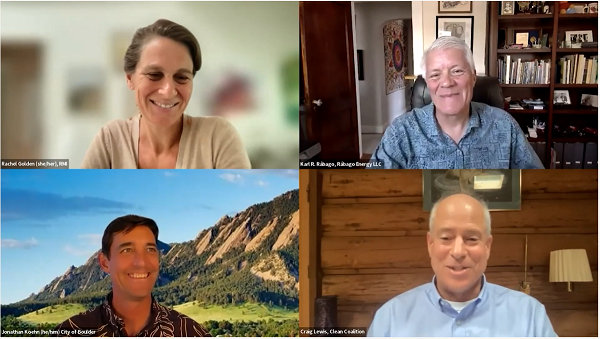The 9th Annual Hawaii Energy Conference (HEC) returned to the virtual stage with 368 participants joining the conversation on “Electrification: Where are we now? What does the future hold?”.
Presented by Maui Economic Development Board (MEDB) and supported by the County of Maui Office of Economic Development, the online two-day conference May 10 and 12 brought together experts on energy policy, strategies, leadership and innovation to revisit all the aspects of electrifying the grid and transportation—current successes, potential pitfalls, and future opportunities.
The Hawaii Energy Conference provides a forum for the exchange of ideas on how to better serve the community in today’s rapidly changing power generation and delivery environment. In his opening welcome. Mayor Victorino stated, “Hawaii is a leading state for solar energy in the nation with a goal of 100-percent renewable energy by 2045. Our famous trade winds can help generate electricity and we have the potential to capture wave energy and geothermal for our energy needs. We have sustainable energy, and an abundance of sunshine and resources to help us. We look to the engineers, scientists, and other experts at this conference to help the people of Hawaii make a transition to renewable energy sooner than later.”
The virtual conference featured keynotes, panel discussions, interviews, networking, and exhibits. Panel’s discussed Electrification in relationship to — the Community; Transportation; Battery Storage; Carbon, Climate Resiliency, Energy Efficiency and more.

Leslie Wilkins, MEDB President and CEO said, “Electrification will completely impact how we approach the issues of energy, production, distribution, energy equity, resilience, and more. Our program focused on the challenges and opportunities before us all in building a resilient, sustainable, affordable, secure, and equitable energy future.”
The opening keynote was presented by Abigail Anthony of the Rhode Island Public Utilities Commission. She spoke on the topic “When Tradewinds Blow: Maintaining Course during the Energy Transition.” In an interview format Commissioner Anthony said, “Rhode Island, the smallest state in the country, roughly the size of Oahu, asserts that right rates and benefits are needed in order to encourage residents to convert to electrification. Electrification is no longer just for early adopters; it is ready to go to scale. We are focused on advancing equity, by making sure our customers are paying only for things that they can benefit from as well as afford.”
Electrification and Energy Efficiency
Caroline Carl, newly appointed Executive Director of Hawaii Energy, gave a Spotlight Talk on Energy Efficiency. She said “The role of energy efficiency is important in the movement to electrify almost everything. Hawaii Energy, the rate-payer-funded energy efficiency program serving the islands of Maui, Oahu, Hawaii, Molokai, and Lanai, operates directly under contract with the public utilities commission. Our mission is to help local families and businesses make smart energy choices.”
This model began when Hawaii’s first clean-energy initiative was formalized in 2008 when the state committed to achieving 70 percent clean energy by 2030. Forty percent was to be from renewable generation and 30 percent from energy efficiency and conservation. This led to the establishment of the state’s energy efficiency portfolio standards, which set a reduction goal of 4300 gigawatt hours by 2030. The Hawaii Energy programs were created to help realize these goals.
“Today the Hawaii Energy programs have saved the people of Hawaii more than a billion dollars off their energy bills by helping them make smart energy choices,” Carl pointed out. “Nevertheless, the programs of the past decade are not what the programs of the next ten years will look like. We are facing a time of significant change across the entire energy landscape. Our programs will need to respond to the impact associated with the number of external drivers. As we face power plant retirements on Oahu and Maui, increasing concerns around capacity reserve shortfall and the Covid pandemic economic impacts remain significant even though looking ahead the outlook appears positive as the global economy continues to recover. Despite all these competing forces, at Hawaii Energy we believe the efficiency programs are key to helping customers and transforming the market for clean energy.”
Day 2 – Keynote Amy Jaffe
Day 2 kicked off with a keynote presentation by Amy Myers Jaffe. The Research Professor and Managing Director of the Climate Policy Lab at the Fletcher School of Tufts University is a leading expert on global energy policy and sustainability.
Considering the question ‘Why Electrification.’, Jaffe said, “We are about to face a major shortfall of diesel fuel throughout the global commodity market. With Hawaii being vulnerable to the volatility in the price of diesel fuel, it does seem that energy security is going hand in hand with decarbonization in thinking about the impetus for electrification.”
“And everything is digital today, everything is connected to your smartphone, it’s all automated, based on data and therefore everything runs on electricity.” she added.
A Conversation with Shelee Kimura
Later on Day 2 Jacqui Hoover, Executive Director at Hawaii Island Economic Development Board and HEC Program co-chair, interviewed Shelee Kimura, the newly appointed President and Chief Executive Officer for Hawaiian Electric. Kimura currently leads Hawaiian Electric’s strategy to provide safe, affordable, reliable clean energy for customers on the islands of Oahu, Hawaii, Maui, Lanai and Molokai. With her leadership, Hawaiian Electric plans to cut carbon emissions from power generation 70-percent by 2030. Kimura’s vision is to generate electricity with zero or very little carbon emission by 2045, if not sooner.
“Meeting our 2030 commitment will be a stretch, but it is achievable if public policies and community priorities are aligned to ensure that this energy transformation leaves no one behind,” Kimura explained. “Equity is an important issue at Hawaiian Electric. We have been focused on it for many years and we look at it in many ways. From a financial perspective, we want to make sure everyone can afford our transition to renewable energy. Also important is equity from a geographic perspective. We need to integrate many megawatts of renewable energy and we know that takes a lot of land. These conversations about where the projects will be sited, how they will be sited, the relationship with community—these are all really important topics that we have been trying to nurture over the last several years. We know that as we put more and more renewables on the electric power system there will be challenges. It is an issue that the entire energy eco-system cannot ignore.”
In addition to watching the presentations live, participants were able to connect and network with each other and sponsors through the virtual platform. Participating sponsors and exhibitors were: Hawaii Natural Energy Institute; Ulupono Initiative; Hawaiian Electric; Kauai Island Utility Cooperative; Burns & McDonnell; Elemental Excelerator; G70; Hawaii Energy; Hawaii Gas; Innergex; Progression Hawaii Offshore Wind; Shifted Energy; and AES.
“There is no doubt that the push to electrification will affect our way of life,” concluded Frank De Rego, Jr., Director of Business Development Projects, MEDB, and Co-Chair of the Conference Program Committee. “Electrification demands attention, among other things, to upgrading the grid, working out a reasonable and responsive regulatory framework, and responding to community needs and concerns, including equity.”
The Hawaii Energy Conference is planning a return to an in-person event on Maui in 2023.

Rhode Island PUC gave the keynote on Day 1 of the Hawaii Energy Conference




